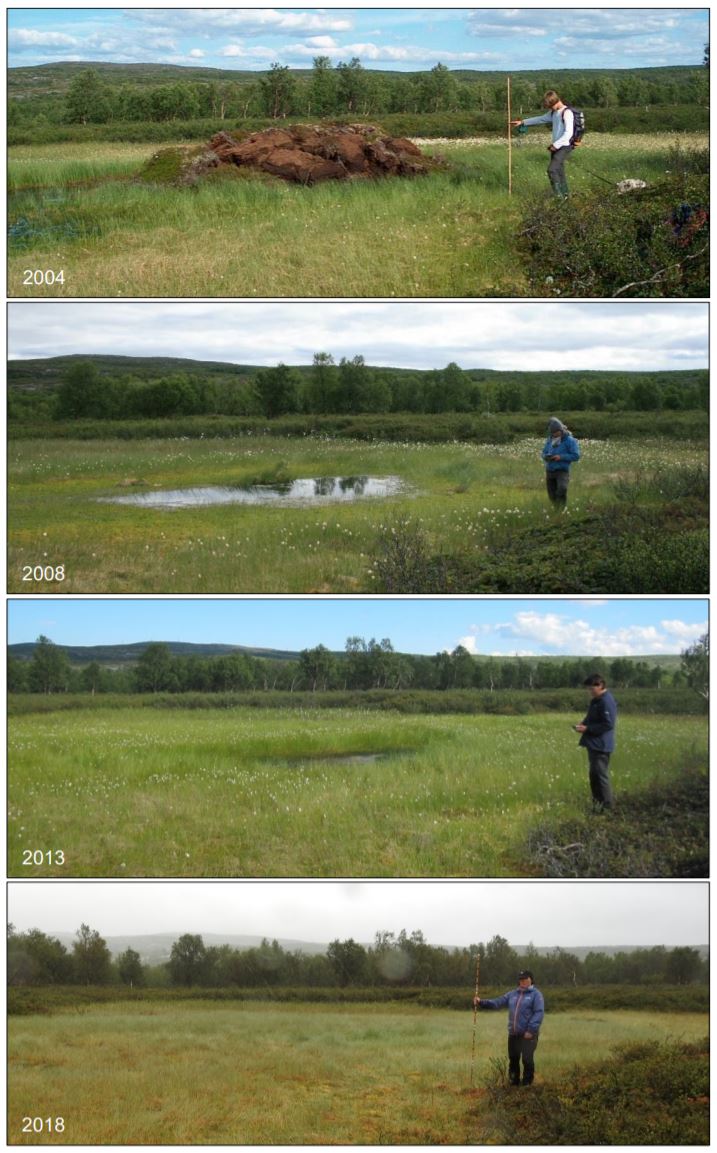De artsrike palsmyrene er en av naturtypene NINA overvåker for å følge med på hva som skjer når klimaet endres. Nå er mange av dem i ferd med å forsvinne for godt.
NINA har siden 2004 fulgt med på hva som skjer med palsmyrene gjennom et nasjonalt overvåkningsprogram, på oppdrag fra Miljødirektoratet. Ferdesmyra i Øst-Finnmark ett av disse områdene. Palsområdene i Ferdesmyra har krympet betydelig, og de fleste palsenene som fantes på 1970-tallet er nå helt borte.
Viktige områder for mangle fugler
– Folk tenker at det er en kolle i terrenget, men når du står på en pals står du faktisk på flere meter med is, forklarer NINA-forsker Annika Hofgaard.
Palsene er torvhauger med permafrost inni, omgitt av en mosaikk av dammer og våte myrområder. Der de troner over det omkringliggende myrlandskapet, er de flotte utkikkspunkter.
Stødig som fjell er palsene imidlertid ikke. De er stadig i forandring.
– I gunstig klima blir palsene større og større, før de kollapser, forklarer Hofgaard.
Vekst og forfall av palsene gir et dynamisk og sammensatt miljø av dammer, kantsoner og palser.
– Dette gir et stort mangfold av insekter, som igjen gir en stor rikdom av fugler, forteller Hofgaard.
Palsmyrene er viktige hekkeområder og leveområder for mange arter av vadere, ender, rovfugl og spurvefugl. Områdene er også viktige rasteplasser for trekkfugler, som trenger mye næring på de lange fugletrekkene.
I ferd med å tine bort
Nå er imidlertid denne spennende naturtypen sterkt trua. Varmt og fuktig klima får palsene til å tine.
Tilbakegangen er et resultat av en prosess som har gått over lang tid, i takt med at klimaet har endret seg. Siden 1970-tallet har årsmiddeltemperaturen økt med nesten 2 C, noe som gjenspeiler seg i de krympende palsmyrene.
– Ferdesmyra er mest utsatt av områdene vi overvåker, sier Hofgaard.
Ferdesmyra ligger i et område der årsmiddeltemperaturen ligger nær 0oC. Slike områder er spesielt sårbare for klimaendringer, og selv små temperaturendringer kan gi store utslag. Siden starten av 2000-tallet har årsmiddeltemperaturen i området ligget over 0oC.
Palsene forsvinner og dammene og de våte myrområdene gror igjen til vanlig myr. Det gir et mer ensartet leveområde, noe som vil kunne redusere artsmangfoldet og mengden insekter.
Hofgaard forteller om flere palser som var mange hundre kvadratmeter på 1970-tallet, men som i dag er helt borte.
Det alarmerende er at den gradvise forsvinningen av palsmyrene er en enveisprosess.
– Dette er en naturtype vi ikke kommer til å ha i et fremtidig varmere klima, sier Hofgaard.

Pals i Ferdesmyras nordre del. Det øvre bildet fra 2004 viser at palsen er i en rask nedbrytningsfase. I det midtre bildet fra 2008 er palsen helt borte og en dam er dannet der palsen lå. I bildet fra 2013 er store deler av dammen igjengrodd med torvmose og myrull. I det nederste bildet fra 2018 vises den opprinnelige palsen kun ved glissen myrvegetasjon.. Foto: Annika Hofgaard / NINA.
Viktig klimaindikator
Kanarifugler var gruvearbeidernes alarmklokker mot skadelige gasser i kullgruvene fordi de var mer følsomme for gasser enn arbeiderne. Stoppet kanarifuglen å synge, var det fare på ferde.
På lignende måte kan vi si at palsmyrene er kanarifugler i klimasammenheng. Fordi palsmyrene er en naturtype som er følsom for klimaendringer, er de viktige indikatorer som forteller oss om endringer som skjer.
Kunnskap om effekten klimaendringer og andre påvirkninger har på naturen er dessuten grunnleggende i vårt arbeid med framtidsretta og helhetlige miljøløsninger. NINA har derfor en rekke overvåkningsprogrammer som til sammen dekker mange naturtyper og arter.
Les mer: NINA Rapport 1665: Overvåking av palsmyr – Andre gjenanalyse i Ferdesmyra, Øst-Finnmark. Endringer fra 2008 til 2018.
Mer informasjon om klimaeffektforskning i NINA
Mer informasjon om NINAs overvåkning av palsmyr
Mer informasjon om miljøovervåkning i NINA
Kontaktperson: Annika Hofgaard